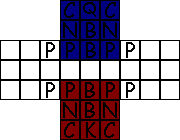King and Queen
- Introduction
- This is a game I created for the 39-square chess variant design contest. It is a fairly simple game with a unique board layout. The goal of the game is to checkmate the other player's king or queen.
- Board
- The board has a total of 39 squares: two row of three squares, then three rows of nine squares, then another two rows of three squares, shown as follows:
- Pieces
- There are five different types of pieces, each has a general and specific name for each side (red and blue). To accommodate for promotions and dropping, it is best to use flat pieces that can be flipped, and also pointing like an arrow. An example is a Shogi playing piece, with one side denoting the regular piece and the other side the promoted piece.
- Promotions
- Promotions are rewarded upon capture of an opponent's piece. Each side has a unique name for each piece and its promotion.
- Dropping
- Upon capturing an opponent's piece, you can drop that piece back on the board. There are several rules on dropping:
- You cannot drop on the same turn you capture.
- You cannot drop if you dropped last turn.
- You can drop only one piece per turn.
- You drop instead of moving.
- You can only drop on an empty square of your castle.
- Dropped pieces are in their unpromoted state.
- Rules
- There are a few additional rules to the game:
- The player on the Queen's side goes first.
- The King or Queen cannot move into a square which puts it into check.
- Upon check, the player must move out of a check; if the player fails to do that, he/she loses. Also called checkmate.
- If a player's only move is into a check, that player loses. Also called stalemate.
- As in XiangQi, a king or queen cannot move into a vertical rank as the opponent's king or queen if there are no pieces in between.
- Notes
- Most of the inspiration for this game is from XiangQi, or Chinese Chess, including the castle, different names for each side, the cannon, the 'checking' rule for king and queen with no pieces in between, etc. Other inspirations come from other types of chess, including regular chess, shogi, etc.

P = pawns, N = knight, B = bishop, C = cannon, K = king, Q = queen.
One player is the Queen (blue) and the other is the King (red). The blue
and red colored squares represent the respective color's castle. The King
and Queen cannot go out of his or her castle.
Pawns move one square forward. Promoted pawns move any number of squares horizontally or vertically.
Bishops move one square diagonally. Promoted bishops move any number of squares diagonally.
Knights move one square horizontally or vertically, then one square diagonally, like a knight in XiangQi, which means it can't 'jump'. Promoted knights can 'jump' as in orthodox chess.
Cannons move any number of squares horizontally or vertically, but capture over another piece, like a cannon in XiangQi. Promoted cannons can move diagonally.
King and Queen move one square horizontally or vertically within the castle. Promoted king and queen can move one square in any direction within the castle.
The Queen's Side
(pawn) Amazons are promoted to Valkyries.
(bishop) Shamans are promoted to Druids.
(knight) Riders are promoted to Pegasi.
(cannon) Spearmen are promoted to Archers.
(queen) Queen to Empress.
The King's Side
(pawn) Soldiers are promoted to Veterans.
(bishop) Bishops are promoted to Saints.
(knight) Knights are promoted to Dragons.
(cannon) Catapults are promoted to Cannons.
(king) King to Emperor.
Copyright 1998 © Dennis Xay Voong. Last updated Oct 30/98.
This is a submission for the contest to design a chess variant on a board with 39 squares.
Written by Dennis Xay Voong.
King and Queen can be played with the Zillions of Games program. To play King and Queen if you have this program, download the zip-file containing the necessary files. Zrf-file by David Howe.
WWW page created: November 2, 1998. Last modified: February 9, 1999.